#king zog i of albania
Photo



U prehtë në paqe, Geraldine of Albania. Born to Hungarian aristocracy during the Austro-Hungarian Empire’s waning years, Geraldine Apponyi de Nagy-Appony eventually worked as a shorthand typist after her family’s fortune was spent before catching the eye of King Zog I of Albania (incidentally, Geraldine was Catholic, Zog was Muslim) and marrying him in 1938 under the watchful eye of Il Duce’s son-in-law and heading off for their honeymoon in a Mercedes-Benz provided by Adolf Hitler. When Albania was invaded by the Italians a year later, the royal family fled, never to return--at least, never to return as the monarchs of Albania (Zog I died in exile in 1961; Queen Geraldine [who prefered to be called the Queen Mother of Albania] maintained thereafter that their son, Leka, was the rightful king of Albania; Leka’s son, Leka II, is called King Leka II by Albanian monarchists)--Geraldine was finally granted the right of return and did so in 2002, only to die 5 months later on this date at the age of 87. Oh, the Balkans.
Stamp details:
Issued on: August 30, 1938
From: Tirana, Albania
MC #274, 276, 278
#Geraldine of Albania#Countess Apponyi de Nagy-Appony#queen geraldine#albania#King Zog I of Albania#stamps#philately#royals#royal family#october 22#shqipni#Shqipëri#Shqipëria#White Rose of Hungary#Queen Consort of the Albanians#Queen Mother of Albania
11 notes
·
View notes
Photo
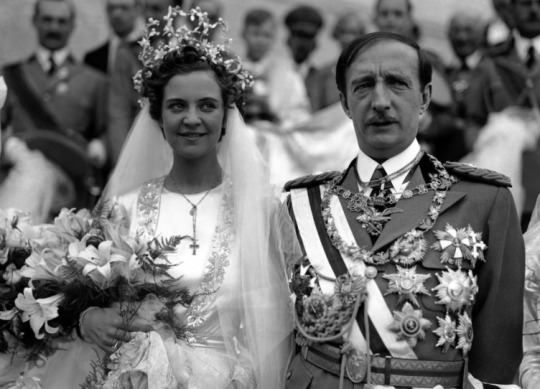
✵ April 27, 1938 ✵
Countess Géraldine Apponyi de Nagy-Appony & King Zog I
#Géraldine#Queen Géraldine#Countess Géraldine#Countess Géraldine Apponyi de Magy-Appony#zog#king zog#zog i#albania#albanian royal family#albanian royal wedding#order of leopold#order of fidelity#order of skanderbeg#order of the gold lion of the house of nassau#royal wedding dress#embroidered wedding dress#beaded wedding dress#royal wedding bouquet#royal wedding veil#military uniform#house of zogu#Royal Wedding
7 notes
·
View notes
Photo
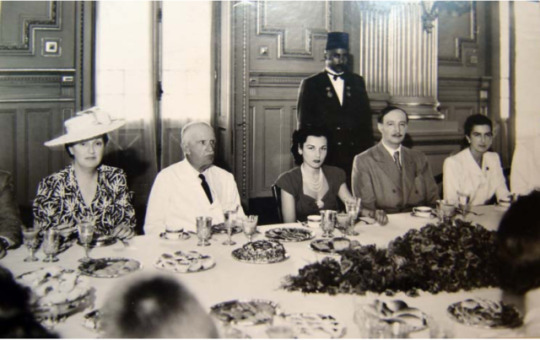
#Zog#King Zog#Vittorio Emanuele III#Mbreti Zog i Parë#fez#tirana italiana#italoalbanica#albania#egitto#albanian
2 notes
·
View notes
Text
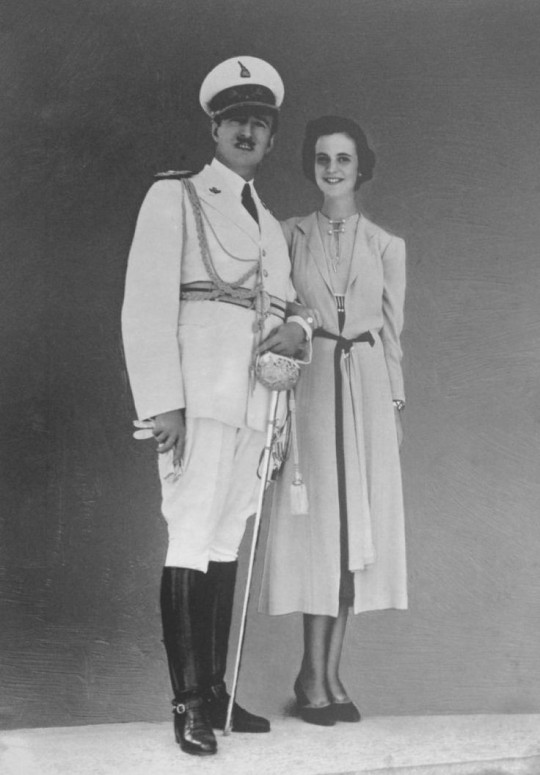
King Zog I of Albania and his wife Queen Geraldine
#king zog of albania#queen geraldine of albania#albanian royal family#albanian history#house of zogu
26 notes
·
View notes
Text
Apparently, (King) Zog knew english but refused to speak it, claiming that only 10% of the language followed the grammar.
#never thought i'd appreciate him#english grammar#king zo#ahmed zog#zog i#albanian#albania#balcan#english#ballkan#balkan
3 notes
·
View notes
Text
FOMA 35: Albania - Future Stories For The Past
The selection of this Forgotten Masterpieces is developed under the reference of the book Albania - Decades of Architecture in Political Context written by Sotir Dhamo, Besnik Aliaj and Saimir Kristo.
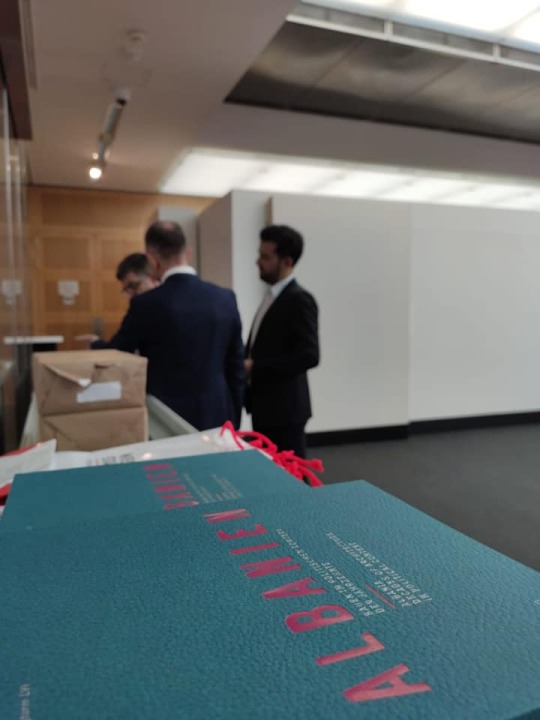
This first volume of FOMA presented by Saimir Kristo include architectures from the administrative and governmental ranks, culture and education buildings, rehabilitation facilities, hotels and hospitalities and remains of regimes.
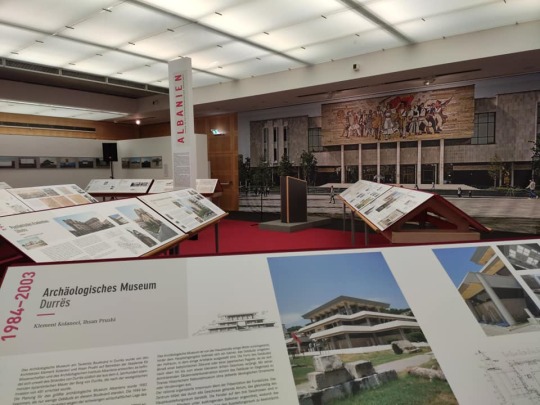
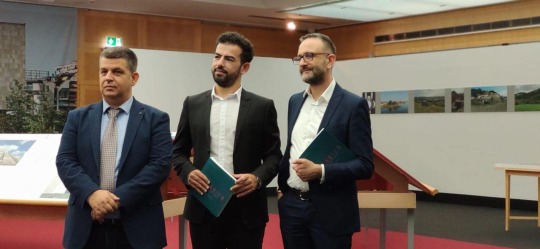
Authors of the book Besnik Aliaj, Saimir Kristo and Sotir Dhamo (from left).
Albanian projects realized between an intense and particular social and political scene involve buildings from the self-declared monarch of King Zog I, to the colony of Imperial Italy under the fascist regime before World War II, up to the rule of the party of labor and the dictatorial regime of Hoxha.

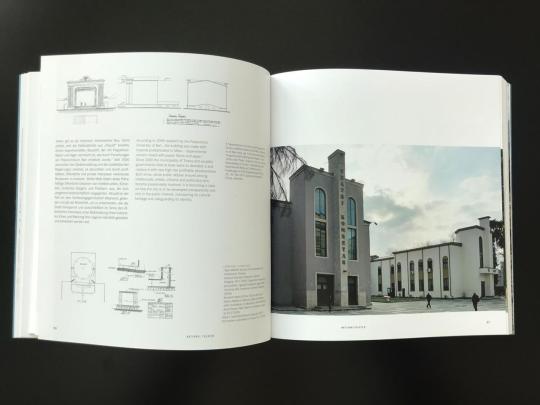
The Royal Villa in Durres constructed by Florestano Di Fausto, Gherardo Bosio, Kristo Sotiri and Armando Brasini was the summer residence of king Zog I and his family. The fashionably styled building has survived as a symbol of the monarchy. According to some sources it was a gift to the king from the business community of Durres, according to another it was given to the king by the Italian government with the intention to strengthen relations between Albania and Italy.
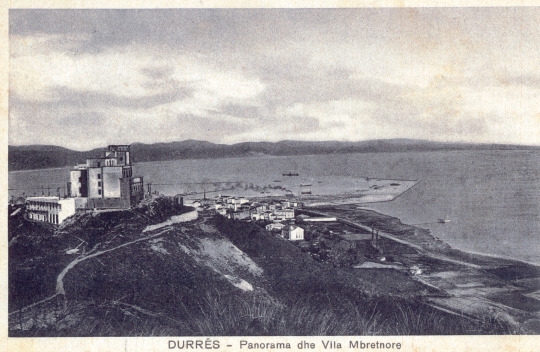

The Royal Villa is situated on top of an adjacent central hill of the city.| Photo via National Technical Archive of Construction Albania
The presence of the kind and his family in Durres, despite his main headquarters in the new capital Tirana, brought about a type of political balance between the two cities and the role they played in the history of the country.
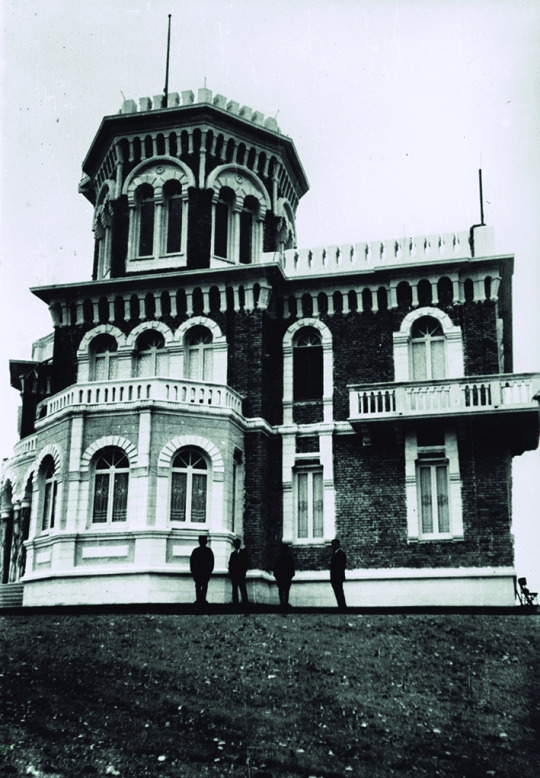
The first concept of the Royal Villa with its own European style was designed by Italian architect Armando Brasini (1929). The final project was finalized by Florestano Di Fausto, assisted by the engineer Antonino Chiesa (1928-1929). Documentation found in the archives show that the original design was in an eclectic style and retained a pre existing structure, which was partially demolished. The intervention of the Italian architect Gherardo Bosio was limited to the interior, transforming the former royal palace into the office of the lieutenant governor as documented in a series of undated sketches.


This building designed by architect Kristo Sotir was later on substituted by the building designed by Florestano Di Fausto. The designs of Bosio and Di Fausto show the dilemma of Italian architects of the 1930s generation, operating between principles of the nineteenth century and rationalism (Giusti, 2006).

With its 360-degree panorama, it offered a view of both, the sea and the land, especially the historic city. Construction of the vila started in 1926 based on the art nouveau concept of the local architect Kristo Sotiri (educated in Padova and Venice) who had previously worked for the Romanina royal family. The works were completed in 1937. After the Italian invasion of 1939 the king and his family were exiled. During World War II and thereafter, the residence was used for government receptions and events. The building was unfortunately looted and damaged during the social and political turmoil of the Albanian rebellion in 1997, and is undergoing a gradual process of reconstruction.

The legibility of this building is based on the contrast of pure volumes on different scales.| Photo via Gizmoweb
The commission for the Dajti Hotel was given to Gherardo Bosio, who was in charge of the General Regulatory Plan for Tirana and the detailed design of the Viale dell’Impero, today Martyrs of the nation Boulevard (Bulevardi Deshmoret e Kombit). Bosio situated the hotel at the boulevard’s crossing with Lana River, where the most representative buildings of the capital stood.

Decaying hotel, hidden behind trees on main boulevard. | Photo via Wikipedia
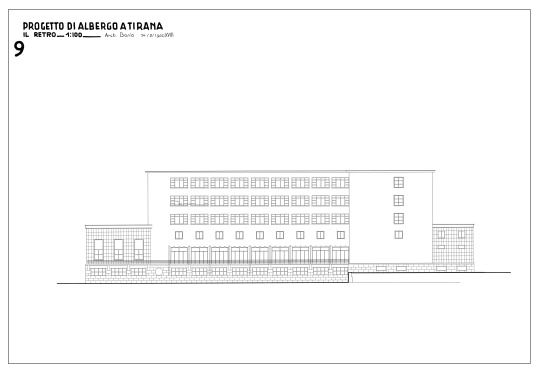

Hotel Dajti just after construction. | Source © Florian Nepravishta, AQTN
The hotel has to follow the design criteria of all the other buildings along the boulevard. Based on the urban regulations issued in January 1940, those criteria concerned primarily the volume, the continuity of the facades and their front length based on multiples of 4-meter modular distances, building width in proportion to road width and the stone cover of the base areas to give them a dignified appearance.
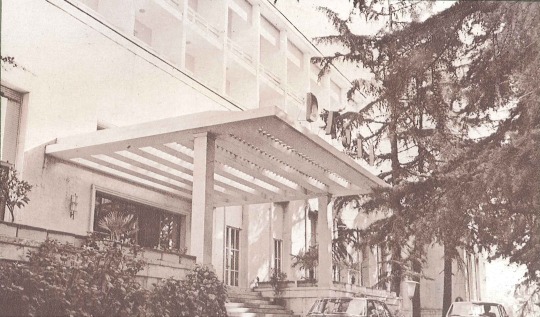
Bosio designed the hotel using a restrained and elegant architectural language. The legibility of this building is based on the contrast of pure volumes on different scales: first, this contrast is created by the distribution of the main corps containing the main programs of the hotel, and on a smaller scale, by carving solids and voids such as balconies and loggias at the level of facades.

Enver Hoxha in front of Hotel Dajti, Tirana 10.7.1945 | Photo via Albanian History
A large staircase covered by a shelter, which bears the hotel sign, marks the entrance. While the base part is of marble, the upper body is plastered. To enhance and animate the appearance of the boulevard, the opening of continuous loggias on the top floors was advised.
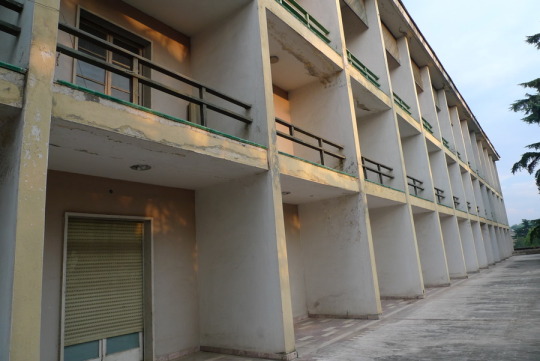
The hotel is not in use anymore today. | Photo © Thomas Haemmerli
The interior, especially its public areas, reveal the complete modernity of the project and its elegance, which is characterized by rational organization of the spaces and clear legibility of the structures. The main hall impresses with light coming from the front and evokes a sense of eternity. Its double volume, supported by pillars, gives an impression of spatial grandeur.


City Logs exhibition by STEALTH.unlimited at the Hotel Dajti during the Tirana International Contemporary Art Biannual. | Photo © STEALTH.unlimited
On the left side of the hall a staircase leads to the upper floor. The gallery overlooking the mezzanine, used for management offices, is clearly visible. The hotel also contains a basement with services, including a late-night bar internally connected with the ground floor bar.
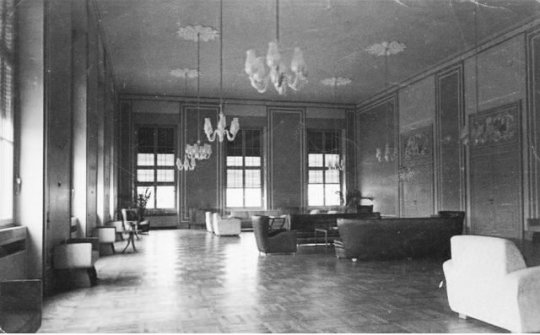

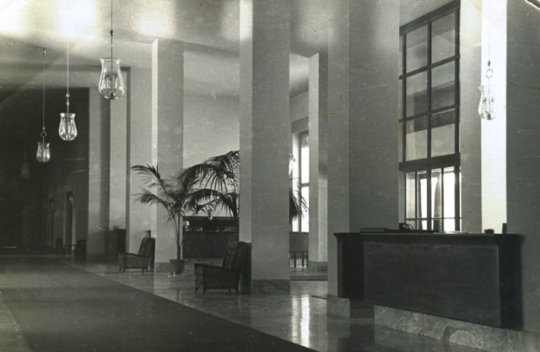
The furnishing parts of the Dajti Hotel, designed in the early 1940s, were designed by Gio Ponti. | Source © Florian Nepravishta, AQTN
Dajti Hotel had everything it takes to be considered an avant-garde hotel. of that period. According to Giusti (2006), the area covered by this building that hosted, on one side, the new hotel and on the other, the offices of the Banca Nazionale del Lavoro, had a surface areas of 2000 m2. If we include atriums, parks and courtyards, the total area amounts to 12000 m2. Gazeta Tomori (in Giusti 2006) states that with i91 rooms and 125 beds, running water, bathrooms and all other amenities including a lift and dumbwaiters, Dajti was one of the largest hotels in the Balkans and the most modern in Europe.

The National Theatre of Albania, built by the construction company Pater Costruzioni Edilizia and the Italian architect Giulio Berte, was completed in 1940. The project was part of the Italian strategy during the occupation of Albania between 1939 and 1943. Two main parallel buildings formed the complex, divided by a half-patio for relaxing, with a pool in the middle and a gym at the front end of the building. The architecture of the complex was based on the principles of the ventennio, as the twenty years of Mussolini’s regime in Italy are called. Initially, the left building was used as the Savoia Cinema for films, theatre and concerts.

The technical infrastructure was entirely suitable for cultural and public events because the building materials offered perfect conditions for acoustics and light technology. It was therefore for a long time also used for meetings and conferences. Albanians could here admire Greta Garbo, Laurence Olivier, Alida Valli, Anna Magnani and attend performances by the composers such as Vivaldi, Paganini, Chopin, Schumann, Verdi, Bellini and Donizetti, not to mention those of the most popular Albanian artists of that time.

The parallel building was the main headquarters of the Skanderbeg Foundation, which undertook several studies and important applications and the forerunner of the Academy of Sciences of Albania under the motto Pro Cultura. Communist authorities use the complex for public show trials or governors accused of collaborating with other enemies. The professional Theatre of the state was located in the building until June 1991 as the Teatri Popullor (People's Theatre).
After the fall of dictatorship, the theatre building was neglected due to the lack of financing. Recently it is in the center of a citizen movement called The citizen’s alliance for the theatre, which is fighting to prevent its demolition from a political campaign that is stigmatizing the building as Fascist and built of poor-quality materials. According to the 2008 research by the Polytechnic University of Bari, the building was made with materials prefabricated in Milan composed of experimental cement mixed with poplar fibers and algae.
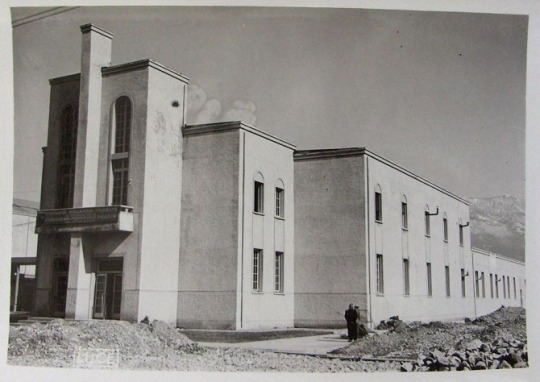
The building after construction. | Photo via Balcanicaucaso
Since 2000 the municipality of Tirana and socialist governments tried at least twice to demolish it and replace it with new high rise profitable developments. Both times, tense public debate ensued among intellectuals, artists, citizens and politicians who became passionately involved. It is becoming a case on how the city need to be developed transparently in the public interest and maintaining its cultural heritage and identity.

Actors in Albania have stormed the country’s national theatre to protest government plans to demolish the iconic building. | Photo via Teatri Kombëtar
Health-care facilities and hospitals are an architectural typology developed in Albania from 1958 to 1988. A number of different hospitals were erected in response to the needs of the country. General hospital centers were established in Berat, Gjirokastra, Tirana and Vlora, infectious disease units in Elbasan and Tirana, obstetrics and gynecology hospitals in Fier, Shkodra and Tirana, pediatric hospitals in Durres and Korce, neuropsychiatric hospitals in Elbasan, Shkodra and Tirana.
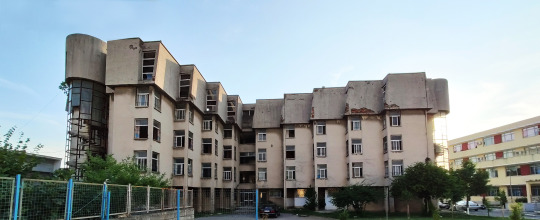


Known as the Psychiatric Hospital of Shkodra, the ensemble was designed in 1982 by Agim Myftiu and Mergim Cano. It is located in the north-eastern part of the city. The floor plan has the shape of a cross, with continuous staggered surfaces on the external perimeter but also in its interior spaces. The space is based on a repeated module consisted by a one room accommodating for patients.

Window openings that allow natural light are placed near the corners of the staggered volumes, creating a unique atmosphere different from that of conventional hospitals. That supports the recovery process of the patients. This particular way of staggering the facade opens new possibilities for the architectural composition of health-care facilities. The service block, developed as a strict volume, is a separate unit positioned on one side of the ensemble with a corridor connecting the two spaces.
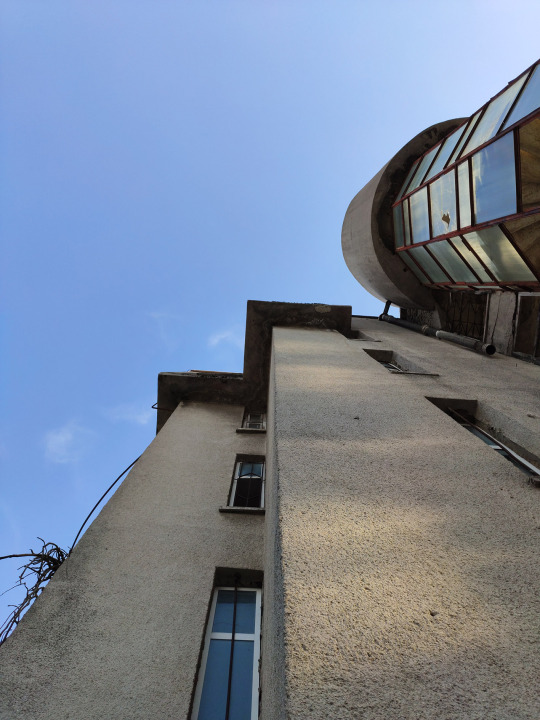
The main entrance placed in the centre of the volume connects also several service entrances for the medical and administrative staff and in such way offers direct access to the various units. Apart from the main block of stairs in the service unit area, all floors accommodating patients are connected with stairs that are positioned in free-standing transparent cylindrical glass volumes. In the basement, apart from the heating and cooling systems, an underground refuge was built, a measure that was commonly taken during the dictatorship period to provide civilians with protection in case of attack.
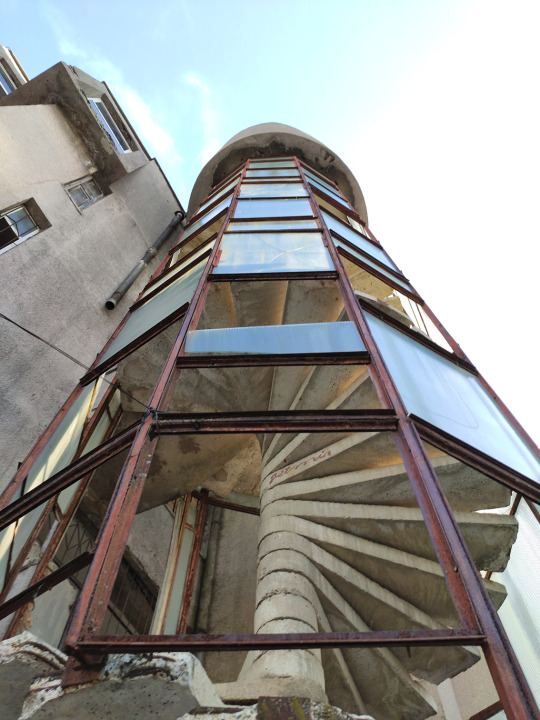
The main characteristic of Tirana’s city center is its monumentality with administrative, cultural buildings and public institutions concentrated along the main boulevard. In 1985, a pyramid building was erected on a former park, today known as Pyramid Square.

The Pyramid of Tirana was meant to house the legacy of the Albanian dictator Enver Hoxha. Four young architects were assigned to design the Enver Hoxha Museum. Klement Kolaneci, Pranvera Hoxha, Pirro Vaso and Vladimir Bregu had to respond to the urgent request to design a monumental new structure with potential sacral character to commemorate for eternity the dictator. The names are not completely occasional since among them are the daughter and the son in law of the dictator.

Designing a building, which was supposed to embody a sacral character, fulfill principles of social-realism and experiment with innovative forms proved to be quite a challenge. Before the project was selected, several alternatives that used the shape of the communist state as their main inspiration, resulting in designs that were too formal and naive were presented. Architects not only drew sketches, but built clay models to assist their understanding of the volumetric relationships.

The Pyramid’s location on the Tirana’s main boulevard between two iconic buildings, the Prime Minister’s office and the Dajti Hotel, required great sensitivity from architects. The architecture would need to respect the existing context of the boulevard and at the same time present a lithic echo of Mount Dajti, which has always been an important natural element of Tirana. Architects combined the socio-realistic principles (star shape, symmetry, processional stairs, raise into a pedestal, etc.) with a pure and articulated form attributing a modern aspect to the building.

The inclined façade of the Pyramid created an illusionary perspective, a unique feature at that time. The placement of the glass windows follows a radial composition around a central axis of rotation. The architectural volume rises 21 meters in height but appears lower due to the inclined planes throughout its exterior, series of platforms and stairs that lead from street level to the entrance. All that allow human scale to prevail. An inclined platform and an underground floor enable an additional entrance on the eastern side. Seen from above, the octagonal umbrella of the façade front is reminiscent of an eagle-wing shape. According to architect Pirro Vaso, architects’ main objective was to create impressive architecture while function played a secondary role. Consequently, architects didn’t choose a grid structure with separated floors but used an open plan, allowing later transformations of the interior space of 17,000 m2.
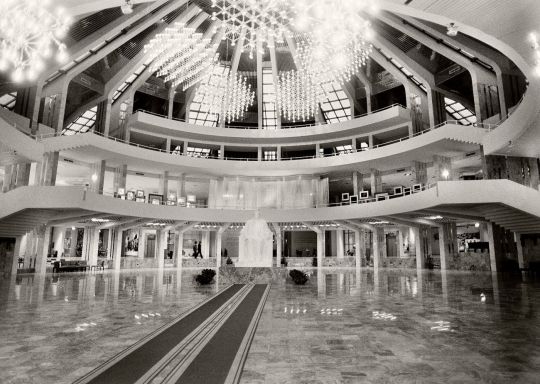
A marble statue of Enver Hoxha in the 1990s.| Photo © Barry Lewis/Corbis
High-quality imported materials and numerous expensive types of marble which covered the exterior and the interior of the Pyramid reveal the symbolic and ideologic importance this building had for the politburo in Albania. Over 4 million dollars are said to have been spent on this building in the 1980s, a time when the poverty level in the country was at its peak. The interior was designed to draw attention to the statue of the dictator, carved in pentelikon white marble (the same marble used for the construction of the Parthenon), at the center of the circular pyramid, which, like the statues of the gods in ancient Greek temples, was to demonstrate a divine presence, enhanced by the communist star on top.

The floor levels are designed as a series of platforms jutting out from the circumference and creating a big amphitheater with a white marble statue of the former dictator at its center. | Foto via Albania Pyramids
The characteristic structure allowed natural light to enter from all sides of the building as well as from a cupola at the very top filtering additional light through its glass cover. The realization of this structure was important not only due to its design and technological achievement but also because it expressed ideological and typological archetypes, such as the linear window development and the lack of vertical walls. As such, this project represents a conceptual shift in Albania at that time. The Pyramid served as a Museum for the dictator from 1988 until 1991. After the fall of the communist regime, the Pyramid was used as an exhibition and fair hall and the square in front became a venue for different public and private events until it was abandoned.
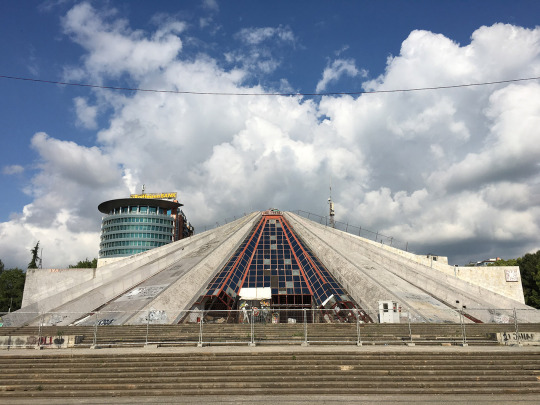
In 1992, the pyramid became the National Cultural Centre, while the square in front of it started to be perceived as a public space and was used by the citizens, becoming at the same time a main tourist attraction. Only after 2000 a discussion regarding the future of this monument began, from change of its function to a preservation as a living provocation reminiscent of the communist period and of course a demolishment.

The Pyramid in 1990s. | Photo via Universal Pictorial Press
However, it was decided to preserve it with a process of renovation that never came to an end. An international competition in 2007 proposed a transformation of the building into a drama theatre and center for the visual arts. Another competition from 2010, won by Coop Himmelb(l)au, proposed a demolition and exchange of the pyramid with a new parliament building in its place. None of the proposals has been realized. A public debate, petitioning and many protests took place in front of the building putting an end to the project and keeping the Pyramid on its place. Instead it become a ground for many experiments including competitions organized by Tirana Architecture Weeks. Lately, a new proposal for the Pyramid was presented by MVRDV intending to convert the former museum of the dictator into a new center for technology, art and culture.
-
Literature:
Giusti (2006), Albania. Architettura e Citta 1925-1943, Maschietto
Vokshi (2014), Tracce dell’architettura Italiana in Albania, DAN Editrice
Hotelet para 1990, zhvillimi i tipologjise ne Shqiperi, Thomai, F., Nepravishta, O Borici, Shtyp Flesh, 2019.
Spiro Mehilli: Botime mbi trashegimine historike te Tiranes.
Aurel Plasari: Mbi Teatrin Kombetar, Lapsi.al 02.07.2018
Spitalet Veshtrim tipologjik mbi arkitekturen shqiptare 1945-1990, Islami, Thomai, Marsida Tuxhari
Xh. Kristo (2018), “Healing Spaces” Architecture space as regeneration of senses”, Diploma Thesis, POLIS University, Tirana
Tirana – city of colours, sto Journal – aRK Magazine, UK, 2018
Interview with Pirro Vaso, “Enver Hoxha” Museum, The Pyramid, 04.2019
Të njihemi me Laureatët e Cmimeve të Republikës, Ndërtuesi Magazine Nr 83, Albanian Ministry of Construction, 1985
Kastriot Dervishi: Historia e Shtetit Shqiptar 1912-2005; Organizmi shteteror, jeta politike, ngjarjet kryesore, ligjvenesit, ministrat dhe kryetaret e shtetit shqiptar. (2006)
Dipartimento di Scienze dell'Ingegneria Civile e dell'Architettura (DICAR), Politecnico di Bari, Italy, VGL, A.B.Menghini, “Experimental building techniques in the 1930s: the ‘Pater’ system in the Ex-Circolo Skanderbeg of Tirana.”, 2013, Epoka-University, Tirana.
S. Kristo, J. Dhiamandi, Albania is NOT an Island. The experimental framework of spatial and architectural interventions in Albania’s capital. ARCHITHESE, Architectural Journal.
All Photos (except the captioned) by © Saimir Kristo, Sonia Jojic, National Technical Archive of Construction, Albania
---
#FOMA 35: Saimir Kristo

Saimir Kristo is a practicing architect, urban designer, lecturer and a Vice-Dean at the Faculty of Architecture and Design POLIS University. His PhD research was focused on city morphology, urban catalysis and public-ness, linked with his experience as the Director of several Regulatory Plans in Albanian cities supported also by USAID. Saimir is an alumnus of the International Visitor Leadership Program by the State Department of the USA and member of civil society. He is a dedicated cultural ambassador into enabling inter-cultural dialogue and collaboration between academia, culture institutions, museums, artists and community developing a common platform for discussion. He curated the two most important architecture and design events in Albania, Tirana Architecture Week 2014: Visioning Future Cities and Tirana Design Week 2015: Design NOW! He was selected as European Young Curator in the CEI Venice Forum for Contemporary Art Curators. He is an international critic and writer and board member of A10 new European Architecture Cooperative, FORUM A+P, Future Architecture Platform and organizer of PechaKucha Night Tirana. He is also a board member of Fundjavë Ndryshe Foundation, a philanthropic foundation that aims to diminish poverty in Albania devoting his skills as an architect building new homes or restoring old houses for Albanians in extreme poverty.
30 notes
·
View notes
Text
I don't know shit about Albania except Zog (that's a person's name, not an antisemitic acronym), the king of Albania, submitted to Italy; Enver Hoxha ruled with an iron fist and put shitty bunkers all over the place; the flag of Albania has been a double-headed black eagle or hawk on a red background since forever; and Yugoslavs and Muslims(?I guess I don't know this, I just know there's that fundamentalist show where a single person, who happens to be Muslim implied severe hatred for Albanians once?) hate Albanians for some reason? Idek
1 note
·
View note
Photo

1 frang ar 1935, Kingdom of Albania period 1925 - 1938. Circulation: 700 000 Obverse: The center depicts a bust of King Zorg I of Albania and an inscription: MBRETI I SHQIPTAREVET / ZOG I Reverse: the inscription goes in a circle:1 FRANG AR / SHQIPNI. In the center is the coat of arms of the Kingdom of Albania Group: SHQIPTARE MBRETNIA Coin artist: Giuseppe Romagnoli. Mint: R - Rome, Italy #coins #coinscollection #coin #worldcoins #silvercoins #hroshen #mycollection #history #antique #money #moneycollection #albania #albaniacoins #frangar #монети #монета #срібнімонети #колекція #колекціямонет #нумізматика #numismatics #numismatica #numizmat #колекціонер #історія #старігроші #oldmoney #oldcoins #нумизмат #монети #монетисвіту (Kyiv, Ukraine) https://www.instagram.com/p/CDHBX-enr69/?igshid=1pyiiptpu5nee
#coins#coinscollection#coin#worldcoins#silvercoins#hroshen#mycollection#history#antique#money#moneycollection#albania#albaniacoins#frangar#монети#монета#срібнімонети#колекція#колекціямонет#нумізматика#numismatics#numismatica#numizmat#колекціонер#історія#старігроші#oldmoney#oldcoins#нумизмат#монетисвіту
2 notes
·
View notes
Text
The military salute
So I was having dinner with a dear American friend who I have mentioned before in a previous post on the British evacuation of Dunkirk I think. He was Exeter and Harvard educated before a stint in the US Marines Corps and now living and working in Paris. As always we get into interesting diversionary conversations about our comparative military experience. Somehow the issue of saluting came up.

He said that when he was growing up he was always told by family that showing the palm is a sign of subordination and submissiveness, and that only a military who has lost a war salutes with palm up. So he was surprised the first time when he received a salute from a passing British army soldier at some military event.
This is obviously untrue but it’s a mystery how that view persisted.
It’s true that both Britain and the US salute differently as do other nations. A soldier will never notice the way he salutes to a superior officer or on formal occasions (like raising the flag) until he/she were thrown in with other officers and soldiers of other allied countries to see the differences.
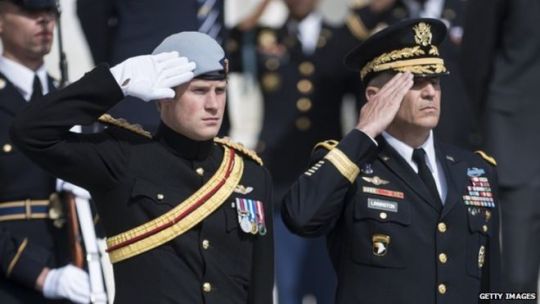
The origin of the military salute
As with many protocols, there’s a secret language to the salute and different expressions of the act of saluting. At the very basis of the salute is something worth pondering at a time when the public debate is trying to sort out what kind of accommodations ought to be made at citizenship ceremonies.
The salute is thought to have originated as a method of demonstrating benign intention. The story goes that public officials in ancient Rome required people approaching them for an audience to raise their right hand to show that they weren’t concealing a weapon. I would imagine it was a field day for left-handed assassins.

The truth is the origin of the military salute is uncertain.
A possible explanation has its origin in the Middle Ages,
Knights adopted a method of assuring other travellers that they meant them no harm. This assurance was transmitted by the raising of the visor on a helmet. Typically, the right hand would rise and lift the metal shield so that the face could be viewed. The right hand was used as it demonstrated that the weapon hand was engaged; the left hand was occupied holding the reins. In time, visors would be modified to have a small metal projection that could be easily lifted to effect this salutation.

This practice evolved to become what we know as the salute: Salute derives from both the Middle English and Old French meaning respectful greeting. You were, in essence, showing yourself.
The simple act of saying, “Hey, it’s just me; nothing to worry about here,” became the way that people in official capacities acknowledged one another. The military adopted salutes as a method of conveying respect and order. Each country found its own unique expression of this message.
However there is a drawback to having this explanation is that if the military salute had a medieval origin, it would have been used to a greater or lesser extent for centuries, but the reality is that it is a rather recent salute, which extended into the Contemporary Age.

Another explanation, more likely, points out that centuries ago there was a habit of saluting a superior by raising his hat. In the 18th Century the ordinances of the British Army suppressed the obligation to uncover the head to greet a superior. Instead, the custom of grabbing the end of the hat was established as if one were to remove the hat, a gesture that would have given rise to the military salute we know today.
Perhaps that explains a detail: as a general rule, in almost all armies, soldiers are exempt from military salutes if they do not wear any headgear. a British order book from 1745 dictates “men are ordered not to pull off their hats when they pass an officer, or to speak to them, but only to clap up their hands and bow as they pass.”

The two main types of military salutes
Currently, and with a few exceptions that I will point out below, in the world military salutes are divided into two main types: with the palm down and with the palm forward. The salute with the palm down consists of raising the arm leaving it at right angles to the body, then stretching the forearm toward the right temple, with the hand extended and the palm of the hand facing the ground.
This salute is the one used in the armed forces of the USA, Russia, China, Spain, Portugal, Italy, Germany, Austria, Belgium, the Netherlands, Ireland, Turkey and practically all the countries of Central and Eastern Europe and in all the countries of Central and South America, and also in the naval forces of the United Kingdom and the Commonwealth: Australia, Canada, New Zealand, India, Pakistan and others.
The other most usual military salute is with the palm in front. The procedure is the same as with the palm down, with the difference that in this case the palm of the hand is left facing the front and perpendicular to the ground. This military salute is used in France (where it is called “raquette”) and in many of its former colonies. The open palm salute is more identifiable in the public imagination (thank you Hollywood) with the armies and air forces of Britain and the Commonwealth countries including Australia, Canada, New Zealand, India, Pakistan and other ex-colonies.

The origin of the American armed forces
According to the Armed Forces History Museum, today’s standard salute - right hand touching the brim of the head cover with the palm down - was in place by 1820. The museum says the palm down portion of the salute may have been influenced by the salute style of the British Royal Navy at the time.
Why did the Americans follow the British Royal Navy? The US copied the British naval salute because they would more commonly encounter the British navy than the British army. So that's the one that got copied; thus the prevalence of palm down salute in the American military.
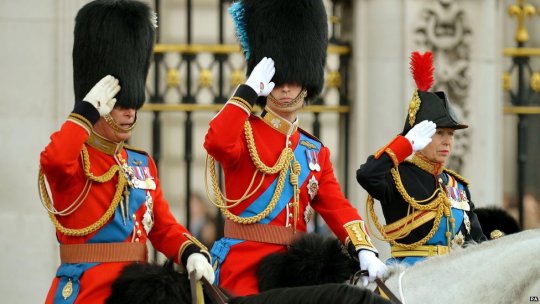
The origin of the different salutes in the British armed forces
Already stated above, in the United Kingdom and in the Commonwealth countries the two salutes are used: with the palm down in the case of the Royal Navy, and with the palm in front in the rest of the army and Royal Air Force.
What is this about?

There is an anecdote that could explain it: on one occasion Queen Victoria visited a warship and a sailor greeted her with his palm in front, his hand rather dirty. The Queen had then decreed that the crew salute with the palm down, because by the work of the ships, it was more frequent that the sailors had their dirty hands and it was bad to salute like that.

The Polish military salute with two fingers
One of the most peculiar military salutes is the Polish, known there as “salutowanie dwoma palcami”, that is, salute with two fingers. The name is because the salute is done as in other nations, but extending only the index finger and the middle, and bending the ring finger and little finger, closing them with the thumb.

The Polish salute has another peculiarity: the main purpose of the salute is to point out the white eagle, the national emblem of Poland, which is why Polish soldiers always wear the eagle in their headwear – with some exceptions – on the front in the center, even when wearing a beret. Currently, the Polish salute is done like French, that is, with the palm facing forward.
Perhaps the custom of saluting with the palm to the front extended in the Polish Army because many soldiers of that country ended up fighting framed first in the French Army and then in the British.
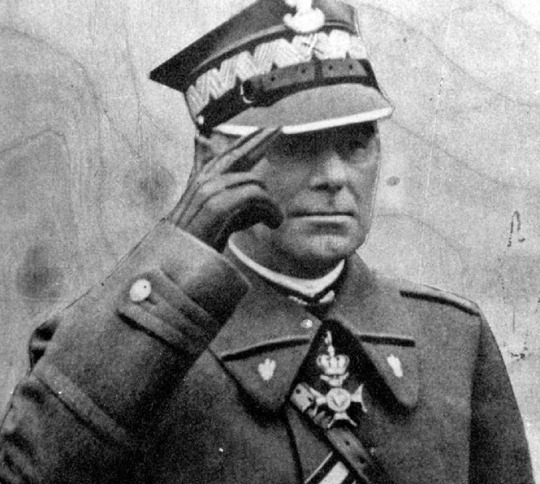
Incidentally, the Polish two-finger salute caused some complaints of British officers during the Second World War, as they considered it a lack of respect, as he thought that the Poles were giving them the Boy Scout salute (which is identical to the Polish, but extending three fingers instead of two). For this reason, the Polish soldiers in the British Army used to make the British salute with the palm in front, at least in the presence of British officers.
The origin of the Polish salute is as uncertain as the rest of the military salutes. The most common legend in Poland locates its origin in the Napoleonic Wars, when a military courier was hit by shrapnel, in spite of which he fulfilled his mission and when arriving before Prince Józef Poniatowski, he greeted him with the three remaining fingers of the hand, dying later. Poniatowski, admired by the bravery of the soldier, would have adopted the military salute for the Polish forces. However, other sources indicate that the salute did not appear until 1863 and would be of Russian origin, being adopted by Marshal Józef Piłsudski after the recovery of Polish independence in 1918, at which time the two-finger salute was made official.

The Albanian chopping salute
Known as the Zogist Salute. King Zog the First of Albania came up with a salute that is executed by placing your hand over your heart with your palm down with a sort of chopping motion.
The Zogist salute is big in Mexico and South America. Our RCMP salute in the manner of the British military, with the palm forward. In Germany, the reviled “heil Hitler” straight-arm salute can land you in jail for up to three years under their current criminal code. Rising from the fact that so many pilots were trained in the air force, airline ground crew tend to salute the pilots of outgoing flights.

Saluting tradition
There are so many ways of communicating via gestures enshrined in tradition: the handshake, the tip of the hat — all intended as acts of friendship. None of the salutes imply obeisance; each is designed to convey respect. In the British tradition, a salute isn’t for the individual but acknowledges the royal commission of the individual: it’s the job, and not the person, who’s being saluted. And the respect is always reciprocated with the salute being returned.
There’s more in a salute than you might think. Their initial impulse was to offset trepidation and inspire confidence; literally and figuratively, to disarm. The gesture went on to indicate respect everywhere from service people at arms and even the Boy Scouts. But the convention of showing oneself to defray concern and offer assurance is genuine and ancient and widespread. There is something in us that wants to see the hand and the face.
50 notes
·
View notes
Text
Did you know that Zog I, King of the Albanians was, unsurprisingly, the king of Albania from 1928 to 1939?
12 notes
·
View notes
Photo

Mbreti Zog l
#Zog#Zog l#King Zog#albanian chieftains#shirtless#culturismo#Ahmet Zogu#Ahmet bej Zogolli#Mbreti Zog i Parë#albania#albanian
7 notes
·
View notes
Photo

King Zog I, of Albania, reigned from 1928–1939 and survived 55 assassination attempts.
3 notes
·
View notes
Photo
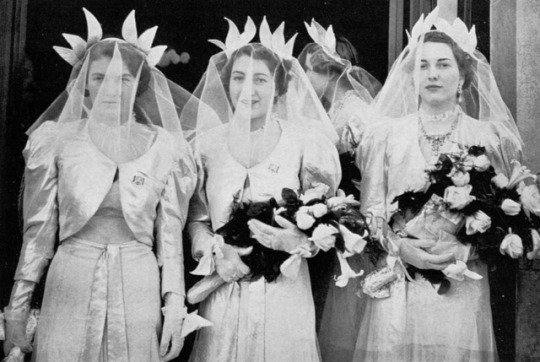
Three sisters (Princess Maxhide, Princess Ruhijé and Princess Myzejen) of King Zog I as bridesmaids at the wedding of King Zog I of Albania and Countess (Geraldine) Apponyi de Nagy-Appony, 1938
72 notes
·
View notes
Text
Events 4.7
451 – Attila the Hun sacks the town of Metz and attacks other cities in Gaul.
529 – First draft of the Corpus Juris Civilis (a fundamental work in jurisprudence) is issued by Eastern Roman Emperor Justinian I.
611 – Maya king Uneh Chan of Calakmul sacks rival city-state Palenque in southern Mexico.
1141 – Empress Matilda becomes the first female ruler of England, adopting the title 'Lady of the English'.
1348 – Holy Roman Emperor Charles IV charters Prague University.
1449 – Felix V abdicates his claim to the papacy, ending the reign of the final Antipope.
1521 – Ferdinand Magellan arrives at Cebu.
1541 – Francis Xavier leaves Lisbon on a mission to the Portuguese East Indies.
1724 – Premiere performance of Johann Sebastian Bach's St John Passion, BWV 245, at St. Nicholas Church, Leipzig.
1767 – End of Burmese–Siamese War (1765–67).
1788 – Settlers establish Marietta, Ohio, the first permanent settlement created by U.S. citizens in the recently organized Northwest Territory.
1795 – The French First Republic adopts the kilogram and gram as its primary unit of mass.
1798 – The Mississippi Territory is organized from disputed territory claimed by both the United States and the Spanish Empire. It is expanded in 1804 and again in 1812.
1805 – Lewis and Clark Expedition: The Corps of Discovery breaks camp among the Mandan tribe and resumes its journey West along the Missouri River.
1805 – German composer Ludwig van Beethoven premieres his Third Symphony, at the Theater an der Wien in Vienna.
1831 – Pedro II becomes Emperor of Brazil.
1862 – American Civil War: The Union's Army of the Tennessee and the Army of the Ohio defeat the Confederate Army of Mississippi near Shiloh, Tennessee.
1868 – Thomas D'Arcy McGee, one of the Canadian Fathers of Confederation, is assassinated by a Fenian activist.
1906 – Mount Vesuvius erupts and devastates Naples.
1906 – The Algeciras Conference gives France and Spain control over Morocco.
1922 – Teapot Dome scandal: United States Secretary of the Interior Albert B. Fall leases federal petroleum reserves to private oil companies on excessively generous terms.
1926 – Violet Gibson attempts to assassinate Italian Prime Minister Benito Mussolini.
1927 – AT&T transmits the first long-distance public television broadcast (from Washington, D.C., to New York City, displaying the image of Commerce Secretary Herbert Hoover).
1933 – Prohibition in the United States is repealed for beer of no more than 3.2% alcohol by weight, eight months before the ratification of the Twenty-first Amendment to the United States Constitution. (Now celebrated as National Beer Day in the United States.)
1933 – Nazi Germany issues the Law for the Restoration of the Professional Civil Service banning Jews and political dissidents from civil service posts.
1939 – Benito Mussolini declares an Italian protectorate over Albania and forces King Zog I into exile.
1940 – Booker T. Washington becomes the first African American to be depicted on a United States postage stamp.
1943 – The Holocaust in Ukraine: In Terebovlia, Germans order 1,100 Jews to undress and march through the city to the nearby village of Plebanivka, where they are shot and buried in ditches.
1943 – Ioannis Rallis becomes collaborationist Prime Minister of Greece during the Axis Occupation.
1943 – The National Football League makes helmets mandatory.
1945 – World War II: The Imperial Japanese Navy battleship Yamato, one of the two largest ever constructed, is sunk by United States Navy aircraft during Operation Ten-Go.
1946 – The Soviet Union annexes East Prussia as the Kaliningrad Oblast of the Russian Soviet Federative Socialist Republic.
1948 – The World Health Organization is established by the United Nations.
1954 – United States President Dwight D. Eisenhower gives his "domino theory" speech during a news conference.
1955 – Winston Churchill resigns as Prime Minister of the United Kingdom amid indications of failing health.
1956 – Francoist Spain agrees to surrender its protectorate in Morocco.
1964 – IBM announces the System/360.
1965 – Representatives of the National Congress of American Indians testify before members of the US Senate in Washington, D.C. against the termination of the Colville tribe.
1968 – Two-time Formula One British World Champion Jim Clark dies in an accident during a Formula Two race in Hockenheim.
1969 – The Internet's symbolic birth date: Publication of RFC 1.
1971 – Vietnam War: President Richard Nixon announces his decision to quicken the pace of Vietnamization.
1972 – Vietnam War: Communist forces overrun the South Vietnamese town of Loc Ninh.
1976 – Member of Parliament and suspected spy John Stonehouse resigns from the Labour Party after being arrested for faking his own death.
1977 – German Federal prosecutor Siegfried Buback and his driver are shot by two Red Army Faction members while waiting at a red light.
1978 – Development of the neutron bomb is canceled by President Jimmy Carter.
1980 – During the Iran hostage crisis, the United States severs relations with Iran.
1982 – Iranian Foreign Affairs Minister Sadegh Ghotbzadeh is arrested.
1983 – During STS-6, astronauts Story Musgrave and Don Peterson perform the first Space Shuttle spacewalk.
1988 – Soviet Defense Minister Dmitry Yazov orders the Soviet withdrawal from Afghanistan.
1989 – Soviet submarine Komsomolets sinks in the Barents Sea off the coast of Norway, killing 42 sailors.
1990 – A fire breaks out on the passenger ferry Scandinavian Star, killing 159 people.
1990 – John Poindexter is convicted for his role in the Iran–Contra affair. In 1991 the convictions are reversed on appeal.
1994 – Rwandan genocide: Massacres of Tutsis begin in Kigali, Rwanda, and soldiers kill the civilian Prime Minister Agathe Uwilingiyimana.[2]
1994 – Auburn Calloway attempts to destroy Federal Express Flight 705 in order to allow his family to benefit from his life insurance policy.
1995 – First Chechen War: Russian paramilitary troops begin a massacre of civilians in Samashki, Chechnya.
2001 – NASA launches the 2001 Mars Odyssey orbiter.
2003 – Iraq War: U.S. troops capture Baghdad; Saddam Hussein's Ba'athist regime falls two days later.
2009 – Former Peruvian President Alberto Fujimori is sentenced to 25 years in prison for ordering killings and kidnappings by security forces.
2009 – Mass protests begin across Moldova under the belief that results from the parliamentary election are fraudulent.
2011 – The Israel Defense Forces use their Iron Dome missile system to successfully intercept a BM-21 Grad launched from Gaza, marking the first short-range missile intercept ever.
2017 – A man deliberately drives a hijacked truck into a crowd of people in Stockholm, Sweden, killing five people and injuring fifteen others.
2017 – U.S. President Donald Trump orders the 2017 Shayrat missile strike against Syria in retaliation for the Khan Shaykhun chemical attack.
2018 – Former Brazilian president, Luiz Inácio Lula da Silva, is arrested for corruption by determination of Judge Sérgio Moro, from the “Car-Wash Operation”.
Lula stayed imprisoned for 580 days, after being released by the Brazilian Supreme Court.
2018 – Syria launches the Douma chemical attack during the Eastern Ghouta offensive of the Syrian Civil War.
2020 – COVID-19 pandemic: China ends its lockdown in Wuhan.
2020 – COVID-19 pandemic: Acting Secretary of the Navy Thomas Modly resigns for his handling of the COVID-19 pandemic on USS Theodore Roosevelt and the dismissal of Brett Crozier.
2021 – COVID-19 pandemic: The Centers for Disease Control and Prevention announces that the SARS-CoV-2 Alpha variant has become the dominant strain of COVID-19 in the United States.
0 notes
Photo

Grim History
Albania’s King Zog and the Politics of Irrelevance
At the turn of the 20th century, Albania was an outpost of the Ottoman Empire. Its landscape was characterized by rugged mountains, deep river gorges, and mosquito infested bogs. Lawless and anarchic, the Albanians were tribal people divided between the Ghegs in the north and the Tosks in the south and further subdivided by the religions of Islam, Catholicism, and Eastern Orthodox Christianity. They had no centralized government and no police force; their societies were barely ruled by a handful of corrupt Turkish beys and the Code of Lek, a medieval system of laws, was sternly obeyed by the tribal society. Blood feuds, where three male members of a tribe were to be assassinated in retaliation for a murder, were the most prominent means of law enforcement.
At the time of the Balkan Wars of the early 20th century, a young Muslim warlord named Ahmed Zogolli from the Mati valley led rebellions against the Ottoman Empire alongside the Serbs, Bulgarians, and Greeks. After the Turks were forced to flee the Balkans, Zogolli became a member of the fledgling parliament of the newly formed nation of Albania. Zogolli became a prominent member of the ruling class until a leftist rebellion fueled by the antagonism of the American educated Fan Noli resulted in an assassination attempt on his life. The leftist rebel faction were supported by the Tosks who saw the new government as being a tool for Gheg domination of Albania. Needless to say, after being shot six times in the arm and chest, Zogolli survived, recovered, and went into exile in Vienna in 1924.
While recovering in Vienna, Zogolli made plans with Serbian agents to return to his homeland and seize power with 600 of his fellow countrymen. After the leftist Tosk coup was overthrown, Zogolli won a sham election and became president of Albania for seven years. He changed his name to Zogu to make it sound more modern and less Turkish. He then wrote a constitution giving himself sweeping executive and legislative powers and the road to autocracy was opened wide for him. He cast himself as a modernizer with the intention of bringing Albania into the modern world. Politically Zogu was more of a dictator, running a police state with strict control over the media. His key piece of legislation was borrowing annual sums of money from Italy to build up the economy, educational system, and infrastructure. Another consequence of his presidency was handing the largely ethnic Albanian territory of Kosovo over to Yugoslavia to return the favor of assisting him in the overthrow of Fan Noli’s Tosk coup.
Death threats were a routine part of Zogu’s presidency. He never went out in public without his mother because according to the rules of the blood feud, women were not to bear witness to a killing.
Then in 1928, President Zogu crowned himself King Zog I of Albania, the first Muslim monarch in Europe. The citizens of Albania were largely indifferent to this event; their nation was one where a largely traditional and illiterate populace cared little about politics, nationalism, or modernity.
As king, Zog lived a secluded life inside his heavily guarded palace in Tirana while sometimes making excursions to his coastal retreat in Durres. He was a soft-spoken, quiet, and gentle man, well over six feet tall, who chain smoked and dyed his hair red with henna. He had no close friends and spent most of his social life with his mother and six doting sisters. Zog’s cabinet members were more like henchmen and he made all political decisions by himself. His method of governing involved little more than paying tribal chieftains large sums of money to leave him alone. Most Albanians did not care for King Zog but it can be said that apathy and fatalism prevented any outright rebellions against him more than anything else. Many found it more profitable to solicit bribes from their monarch than to wage war against him, gambling for something that would probably be worse.
As king, Zog I was involved in more than 600 blood feuds and supposedly survived 55 assassination attempts. The most well-known plot happened in Vienna while recovering from an illness. Zog was shot at by two men after leaving the opera. The bullets hit a a bodyguard, mistaking him for the king. The bodyguard fell on top of Zog in his limousine, involuntarily becoming his human shield . The assassins were apprehended and Zog escaped. They turned out to be two disgruntled expatriates who were possibly supported by Kosovars who wanted their annexed territory to be reunited with a Greater Albania.
Then trouble with Italy began. Mussolini started to demand that Albania repay the money they borrowed but they simply did not have enough capital to do so. Mussolini cut off the loan disbursements, leaving Albania a country with half-constructed bridges and roads and an impoverished educational system. Mussolini’s plan of training Albanian warriors to be foot-soldiers for fascist Italy came to nothing since the Albanians were resistant to military regimentation. After Italy failed to conquer Libya and Ethiopia, Il Duce decided it was time to reinvigorate his country by conquering Albania, thereby bolstering his sagging reputation for military prowess while Hitler’s Germany marched across Europe. At 1:00 am on the night Zog’s wife Queen Geraldine gave birth to the crown prince, Italy invaded by sea and air. At first a small resistance force tried to fight them off with machine guns but soon gave up when they saw they were outnumbered. It is said they cared more about defending their fatherland against the mistrusted Italians than in defending their king. Zog quietly took the queen, heavily sedated after a caesarian-section, his newborn son, and several suitcases filled with gold stolen from the national treasury across the border into Greece.
The royal family eventually settled as refugees first in France and then in London. King Zog spent World War II trying to convince the Allies that he could raise troops to fight off the Italian invaders. They shrugged him off as an eccentric and irrelevant monarch and their interest in fighting Italy to save Albania seemed too much like small fry for their larger strategies. Then the war ended. The terrifying years of Enver Hoxha’s communist regime began. After a couple botched attempts by the CIA and MI6 to overthrow Albania’s government and reinstate King Zog I as monarch, he continued to live on his dwindling funds while his health conditions grew worse and worse each year. Finally King Zog, the founder of the modern Albanian nation, died at the age of 65.
Tomes, Jason. King Zog of Albania: Europe’s Self-Made Muslim Monarch. New York University Press, 2003.
4 notes
·
View notes
Photo

King Zog of Albania via reddit I wasn’t able to find much... https://ift.tt/2yqoY6n
2 notes
·
View notes